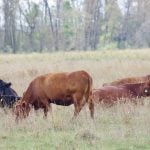The water in Allan Downey’s cavernous dugout should be 10 feet over his head. Instead, it’s just a small pool at his feet. It’s not nearly enough to get his cattle through the coming winter. What Downey prays for is an old-fashioned winter with six-foot snowdrifts and adequate spring run-off to recharge the dugout and



